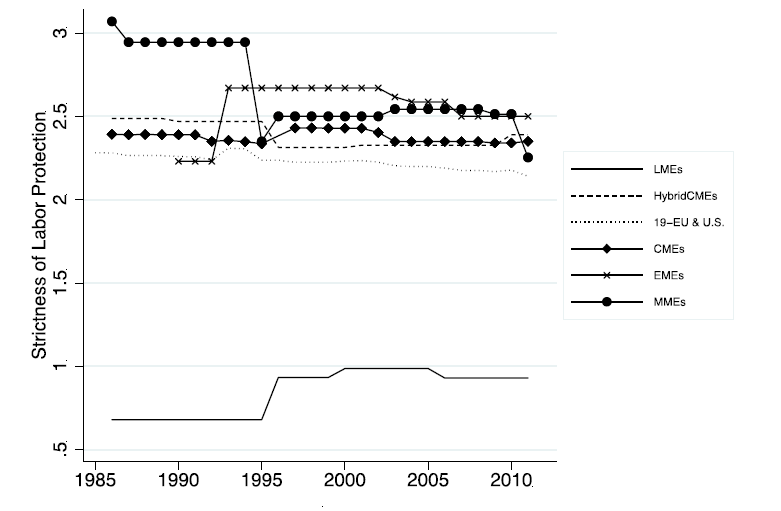Blog
Seminar paper: Entrepreneurs and unicorns
 Today our very own Selin Dilli presented in the seminar. Selin completed her PhD within the project “Agency, Gender, and Economic Development in the World Economy, 1800-2000” with a dissertation focused on measuring the position of women over the long term and a particular focus on women’s political participation. Her paper today was titled “The Diversity of Labor Market Institutions and Entrepreneurship” and is part of her work as a PostDoc in the FIRES project. FIRES stands for Financial and Institutional Reforms to build an Entrepreneurial Society and is a large collaborative Horizon 2020 (EU) project bringing together scholars from different disciplines and universities to provide policy advice to regenerate European entrepreneurial activity.
Today our very own Selin Dilli presented in the seminar. Selin completed her PhD within the project “Agency, Gender, and Economic Development in the World Economy, 1800-2000” with a dissertation focused on measuring the position of women over the long term and a particular focus on women’s political participation. Her paper today was titled “The Diversity of Labor Market Institutions and Entrepreneurship” and is part of her work as a PostDoc in the FIRES project. FIRES stands for Financial and Institutional Reforms to build an Entrepreneurial Society and is a large collaborative Horizon 2020 (EU) project bringing together scholars from different disciplines and universities to provide policy advice to regenerate European entrepreneurial activity.

Today Selin talked to us about what sort of constellations of labour market institutions are positive for various forms of entrepreneurship. Collecting data on the labour market regulation (so ease of hiring and firing), wage-setting (trade union power and centralized wage bargaining) and social security (in terms of pensions, unemployment benefits, etc.) she was able to categorise the 18 European countries and the US which she looks at into clusters based on how similar their labour market institutions are. She shows, also, that these institutions are persistent over time (the graph to the right is from her paper illustrating this point). The overall conclusion of the paper was that there is no one-size-fits-all policy option. When a country wants to improve one’s entrepreneurial activity looking to the US might not be the best idea but rather to one with a similar constellation of institutions. For instance, the Netherlands might be best to look to Germany (and specifically Berlin) as an example, rather than attempting to replicate Silicon Valley in Eindhoven. An interesting point raised is the importance of informal institutions in all of this. Informal institutions are things like culturally accepted modes of behaviour, the fact that risk is more acceptable in the US than here, the existence of wider family networks, etc. The interplay between formal and informal institutions is important to take into account when designing policy, and this echoes closely Selin (and my own) work on the position of women were we argue that one has to take family structures into account if you strive to achieve great equality between men and women.
 This brings me to unicorns – one aspect that Selin didn’t touch upon in this paper, but which her wider work is interested in is what explains the gap in entrepreneurial activity between men and women. Sometimes women are argued to be more risk averse, or less individualistic which might make them less inclined to set up their own businesses. However, when they do these can be hugely successful. Diversity in the types of products being brought to the market is essential and women, as an under-represented group, probably still have a lot of scope for imagining new products/services etc. This article from CNN money today highlights that although fewer than 1 in 10 unicorns (start-ups valued at more than $1 billion) were founded by women they are among the world’s most innovative unicorns! So here’s hoping Selin’s continued research comes up with policy suggestions which help governments enable more women to lay the foundations for mythological creatures to arise! Selin or I will keep you updated!
This brings me to unicorns – one aspect that Selin didn’t touch upon in this paper, but which her wider work is interested in is what explains the gap in entrepreneurial activity between men and women. Sometimes women are argued to be more risk averse, or less individualistic which might make them less inclined to set up their own businesses. However, when they do these can be hugely successful. Diversity in the types of products being brought to the market is essential and women, as an under-represented group, probably still have a lot of scope for imagining new products/services etc. This article from CNN money today highlights that although fewer than 1 in 10 unicorns (start-ups valued at more than $1 billion) were founded by women they are among the world’s most innovative unicorns! So here’s hoping Selin’s continued research comes up with policy suggestions which help governments enable more women to lay the foundations for mythological creatures to arise! Selin or I will keep you updated!

